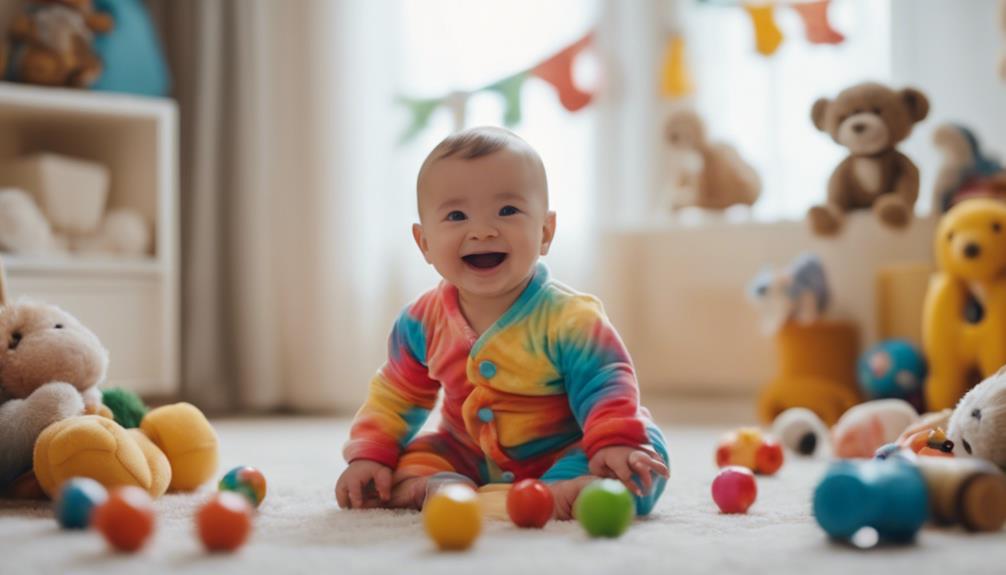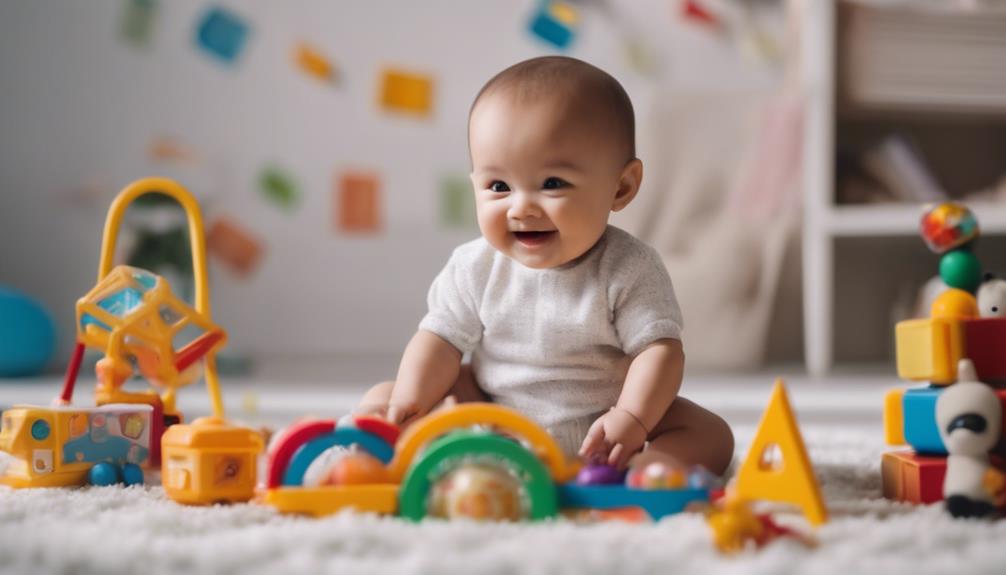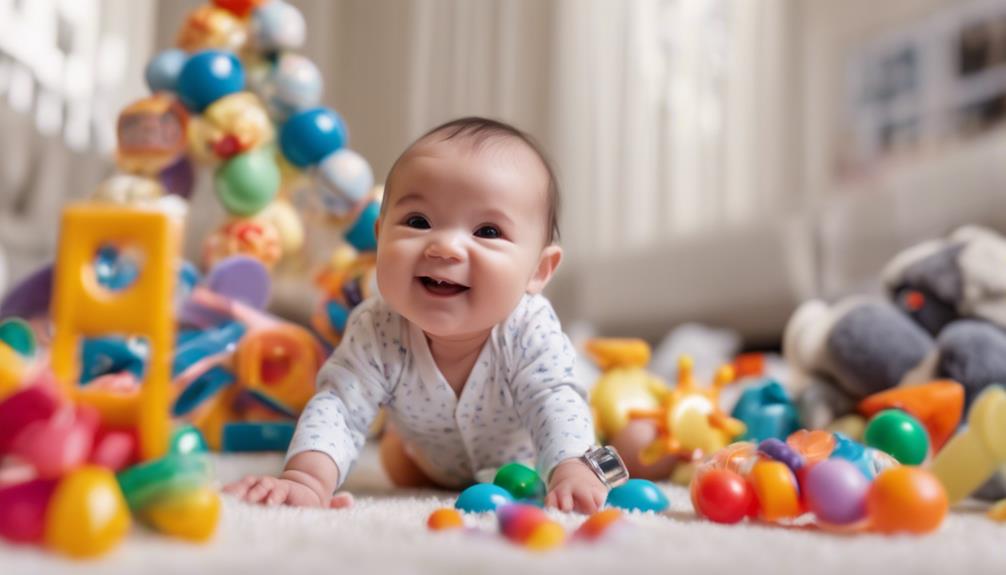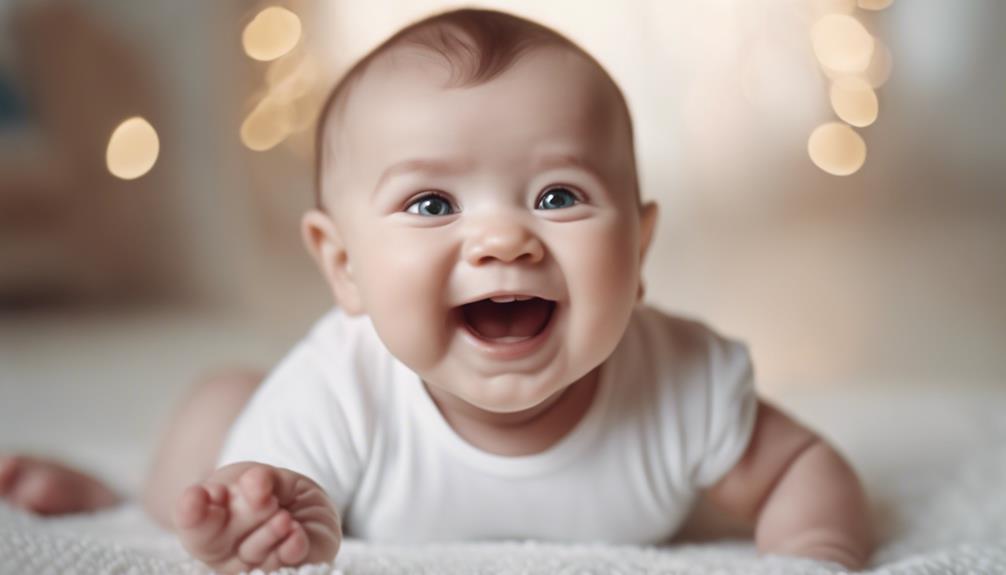When your baby consistently smiles, it signals a crucial milestone in their emotional development and ability to communicate. Their frequent smiles demonstrate a deep sense of satisfaction and connection with their surroundings. These smiles express joy, enthusiasm, and contribute to building strong relationships with caregivers, nurturing positive feelings. A baby’s smile serves as a significant form of nonverbal communication, reflecting their emotional state and eagerness to engage. Recognizing and reciprocating these smiles can enhance your bond and aid in their growth. This happy expression hints at a universe of exploration and connection yet to come.
Key Takeaways
- Constant baby smiling signifies positive emotional well-being and healthy social development.
- Smiling fosters strong connections with caregivers, aiding in attachment and communication skills.
- A consistently smiling baby may exhibit optimism and positive personality traits.
- Interpreting baby smiles involves understanding social cues and emotional responses.
- Creating a nurturing environment and engaging in joyful interactions can encourage a baby to smile more.
Significance of Babies' Smiles
Babies' smiles play an essential role in their social, emotional, and visual development. Social smiling, where babies smile in response to interactions with others, is a significant indicator of their growing communication skills. Research suggests that babies time their smiles strategically, aiming to elicit responses from caregivers and establish connections with them.
Genuine smiles, typically emerging between 6 to 12 weeks, reflect the baby's ability to express pleasure, excitement, and happiness towards those around them. These smiles serve as a form of nonverbal communication, allowing infants to convey their feelings effectively. By engaging in social smiling, babies not only express their emotions but also learn to interpret and respond to the emotions of others, laying the foundation for future social interactions.
The importance of babies' smiles extends beyond simple expressions of joy, playing a critical role in their early development and interactions with the world.
Emotional Meaning of Baby Smiles
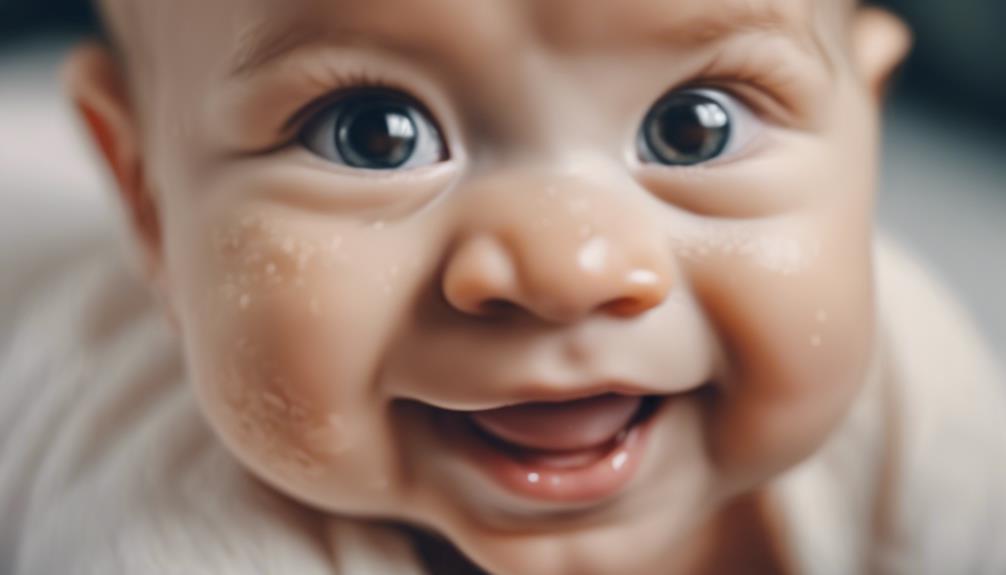
Baby smiles serve as joyful expressions, reflecting their pleasure and excitement.
These smiles help babies connect with others, creating bonds and fostering a sense of joy and love.
Understanding the emotional meaning behind baby smiles can provide insights into their development and communication skills.
Joyful Expressions in Babies
Frequent smiling in infants typically signifies a range of positive emotions and emotional well-being. When infants smile, it's an essential form of affective behavior that indicates feelings of joy, contentment, and happiness.
These joyful expressions are important for babies as they communicate their pleasure and excitement to caregivers, fostering a sense of connection and emotional bonding. Continuous smiling in babies not only showcases their positive emotional state but also plays a significant role in their healthy emotional development.
A baby's smile is a natural way for them to share their happiness, build social bonds, and feel connected to those around them. It serves as a non-verbal form of communication through which infants express their emotions and engage with the world.
As caregivers respond to these joyful expressions, they further strengthen the emotional connection with the baby, creating a nurturing environment for the infant's emotional well-being.
Connection Through Smiling
Through their radiant smiles, infants effortlessly convey a myriad of positive emotions and foster meaningful connections with those around them. This social smile, seen as early as 6-8 weeks old, plays an essential role in child development.
When babies smile, they not only express happiness, pleasure, and contentment but also establish bonds with caregivers and peers. Research suggests that babies are astute in timing their smiles to elicit reciprocal smiles from others, creating a cycle of positive interaction. Additionally, smiling in babies is linked to improved social, emotional, and visual development.
As infants learn that their smiles have an impact on those around them, they begin to engage more actively with their environment, enhancing their ability to form connections and navigate social interactions. Understanding the emotional meaning behind baby smiles sheds light on the intricate ways in which infants communicate and establish relationships from a very young age.
Communication Through Baby Smiles
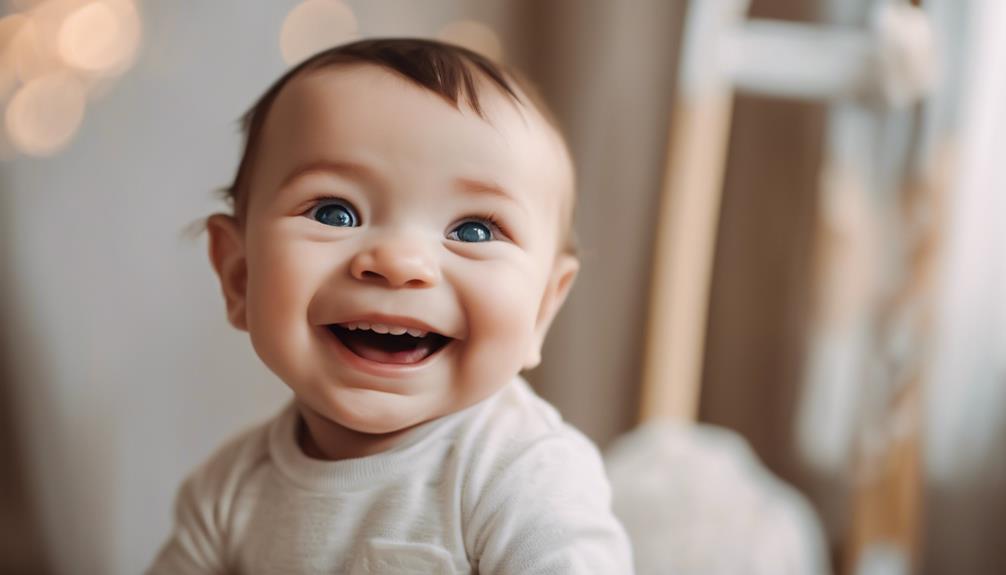
Communication is a fundamental aspect of human interaction, and baby smiles play an essential role in conveying emotions and connecting with others. When babies flash their first smile, they're initiating a form of communication that goes beyond words. Here are some key points to ponder about communication through baby smiles:
- Expressing emotions: Baby smiles serve as a way for infants to express pleasure, excitement, and happiness to those around them.
- Connecting with caregivers: Through smiling, babies learn that they can connect with their caregivers and communicate their needs and feelings effectively.
- Improving recognition: Smiling indicates that babies are developing better vision and recognizing familiar faces, aiding in their social development.
- Signifying importance of emotions: By using smiles, babies show that their emotions matter and can impact the emotions of others, fostering social interactions and bonds.
Babies typically start social smiling between 6 to 12 weeks as they begin responding to stimuli like familiar faces and voices.
Psychological Well-Being of Smiling Babies
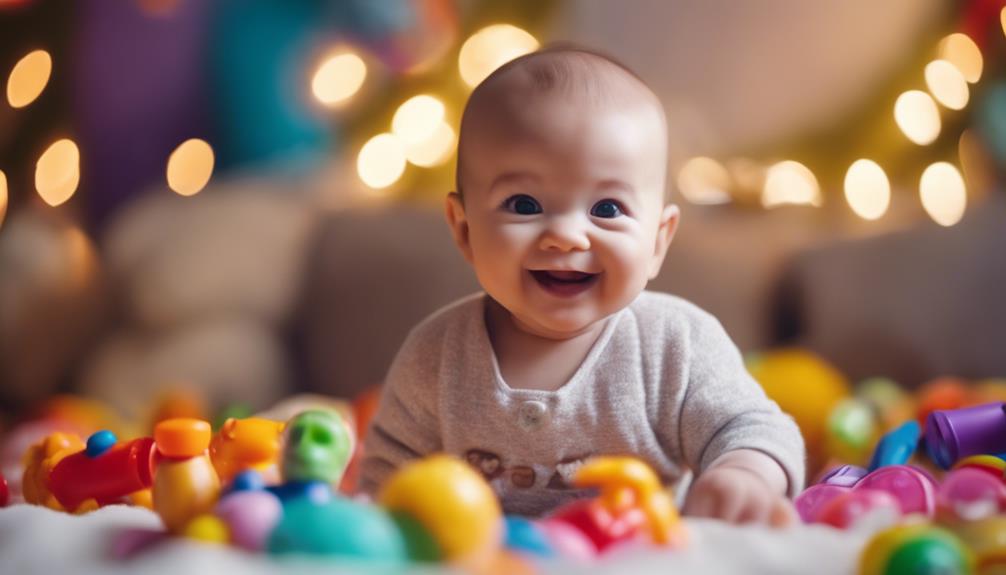
Essential
Smiling babies often exhibit positive personality traits and engage more readily in social interactions, contributing to their psychological well-being. Research indicates that infants who smile a lot tend to develop less neuroticism later in life.
Constant smiling in babies is considered an essential part of their learning process and is typically a sign of healthy social development. Babies use their smiles strategically, timing them to elicit reciprocal smiles from caregivers, showing an early desire for social connection.
Engaging in social interactions from an early age can have numerous benefits for babies, such as improved communication skills, emotional regulation, and forming secure attachments. When babies smile frequently, it signals their readiness to interact and communicate with those around them.
This positive engagement with others can lead to enhanced social development and a strong foundation for healthy relationships in the future. Overall, the act of smiling plays an essential role in the psychological well-being of babies, fostering positive connections and facilitating healthy social development.
Developmental Milestone: Baby Smiles
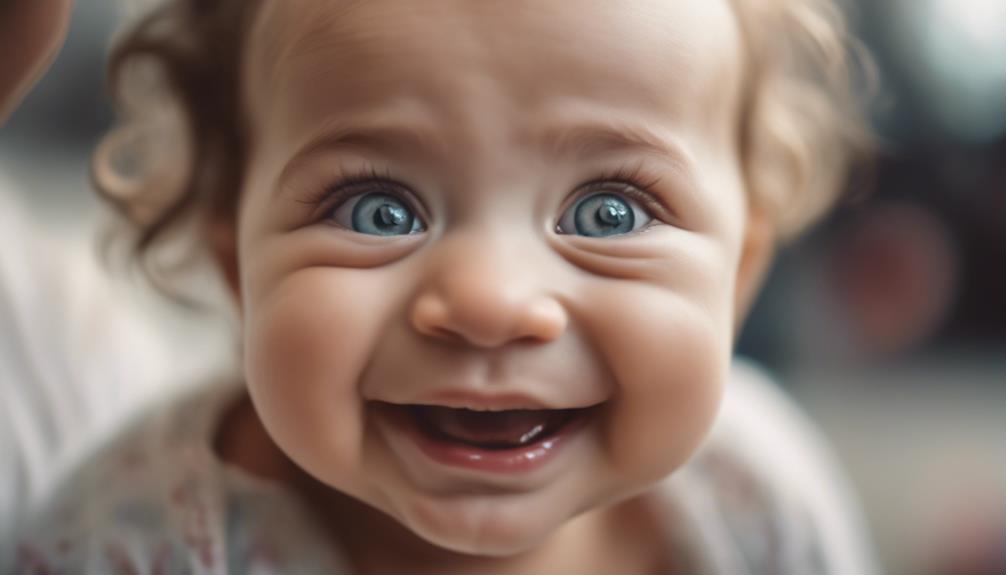
Around 6 to 8 weeks of age, babies typically begin to display smiles as a significant developmental milestone in response to various stimuli. This first display of smiles marks an essential step in your baby's growth and emotional development. Here are a few key points to note about this exciting phase:
- Connection with Caregivers: Babies start smiling to connect with their caregivers, showing trust and building strong bonds.
- Expression of Emotions: Those first smiles are a way for your baby to express pleasure, excitement, and happiness, even before they can speak.
- Communication of Feelings: Through smiling, infants communicate their feelings, indicating an improvement in social, emotional, and visual development.
- Emotional Recognition: Real smiles in babies are intentional responses to familiar faces or voices, showcasing emotional recognition and attachment.
As your baby's smiles evolve from reflexive to intentional, they're enhancing their ability to express joy and share positive emotions with those around them.
Factors Influencing Baby Smiles

To understand what influences a baby's smiles, consider factors such as the development of genuine expressions as they grow and mature. Newborn smiles are often reflexive, but as babies progress to intentional smiling, they may display more genuine smiles during dreaming.
Infants frequently smile during rapid eye movement (REM) or active sleep, which aids in muscle development for future smiling. During active sleep, babies may show complex facial expressions while smiling, similar to adults experiencing dreaming during REM sleep.
Research even suggests that babies who smile more may exhibit positive personality traits later in life. So, the next time you see your little one flashing a grin during their sleep, remember that it's not just a cute sight; it's an essential part of their development that could shape their personality in the long run.
Encouraging Positive Emotions in Babies
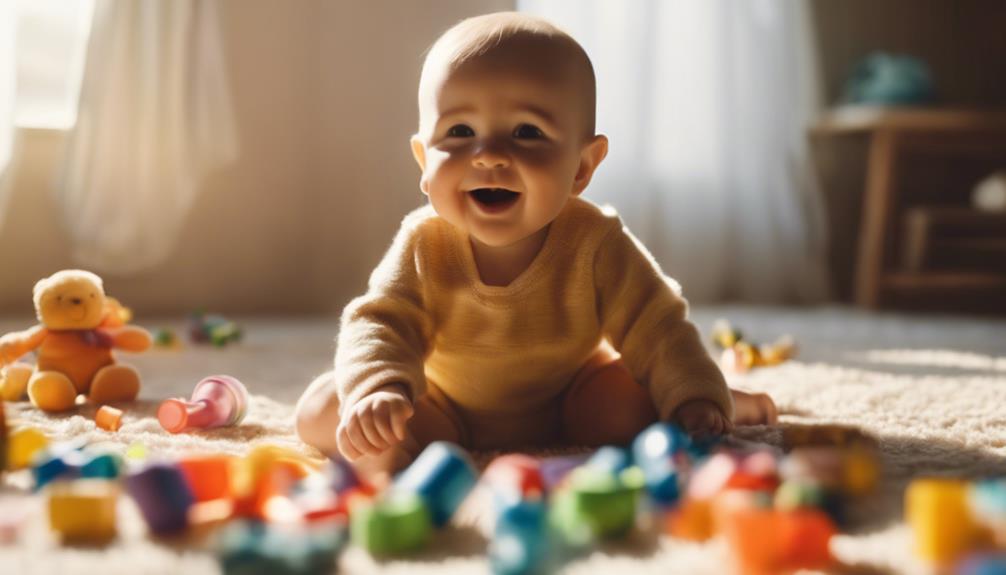
Encouraging positive emotions in infants involves actively engaging in face-to-face interactions, using animated voices, and mimicking your baby's expressions to foster a strong emotional bond. Research suggests that these interactions play an essential role in shaping your baby's emotional development.
To encourage more smiles and positive emotions in your baby, consider the following:
- Respond promptly to your baby's cues, such as cooing or reaching out, to show them that their actions lead to a positive response.
- Use exaggerated facial expressions and playful tones to capture your baby's attention and create a joyful atmosphere for interaction.
- Maintain eye contact during interactions to establish a sense of connection and security, enhancing the emotional bond between you and your baby.
- Incorporate gentle touch and physical closeness during playtime and caregiving routines to provide comfort and reassurance, promoting a sense of emotional well-being in your baby.
Interpreting Baby Smiles

Understanding the meaning behind a baby's smile can provide valuable insights into their emotional communication and developmental milestones. When interpreting baby smiles, it is crucial to take into account various factors such as social cues, developmental delays, and emotional responses. Below is a table that summarizes key points to help you grasp the significance of a baby's smile:
| Factors to Take Into Account | Implications |
|---|---|
| Social Cues | Babies smile to communicate pleasure, excitement, and happiness with caregivers. |
| Developmental Delays | Delayed smiling milestones can sometimes indicate potential developmental delays in infants. |
| Emotional Responses | Smiling indicates improved vision and recognition of faces in babies, showing their emotional development. |
Health Implications of Smiling Babies

Smiling babies often serve as indicators of positive emotional well-being and social development. When babies smile in response to stimuli, such as facial expressions or interactions, it can have various health implications:
- Emotional Well-being: Frequent smiles in infants can indicate contentment, happiness, and a desire to connect with caregivers, fostering a sense of security and emotional stability.
- Social Development: Babies' smiles during interactions help strengthen the parent-child bond and promote emotional communication, laying the foundation for healthy social relationships in the future.
- Caregiver Response: Smiling babies often elicit positive responses from caregivers, creating a cycle of mutual happiness and connection that enhances both emotional and physical well-being.
- Optimistic Outlook: Research suggests that babies who smile frequently may have a more optimistic outlook and positive personality traits later in life, indicating the long-term benefits of early emotional expression.
Cultivating a Happy Environment
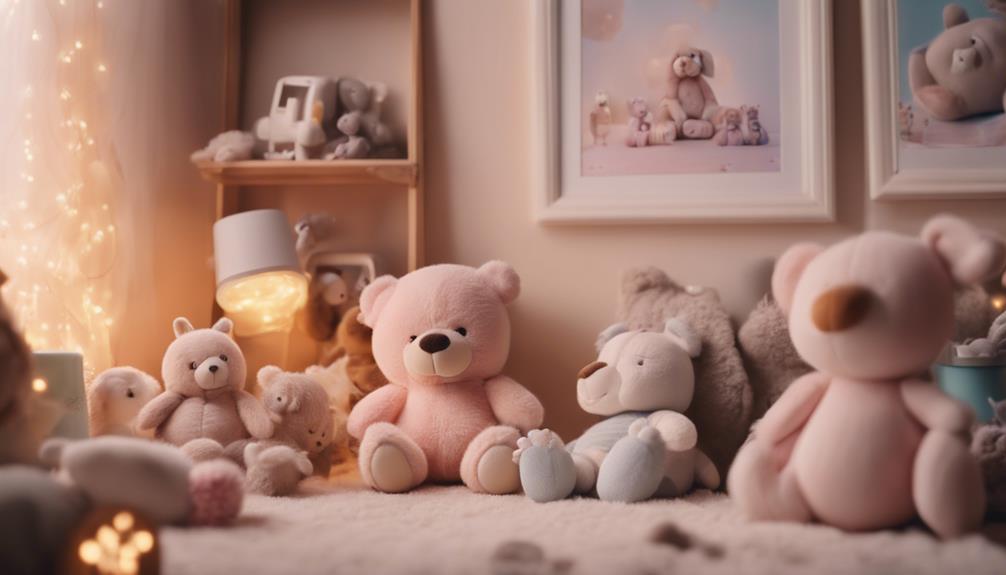
To cultivate a happy environment for your baby, focus on creating positive surroundings that impact their mood positively.
Encourage joyful interactions by engaging in playful activities, making eye contact, and talking to your baby often in a cheerful tone.
Positive Surroundings Impact
Creating a nurturing environment filled with warmth and love can greatly influence a baby's tendency to smile frequently. Babies thrive in positive surroundings, and the impact of a happy and secure atmosphere can't be underestimated.
Here are some key ways in which positive surroundings can impact a baby's propensity to smile:
- Babies learn to smile more: In response to a happy and secure environment, babies feel content and safe, which encourages them to express joy through smiles.
- Nurturing atmosphere: Creating a nurturing atmosphere filled with love and warmth helps babies feel comfortable and happy, leading to more frequent smiles.
- Interactions with caregivers: Engaging with a family member or caregiver in a playful manner can bring out a baby's first smile and encourage them to smile often.
- Supportive environment: A supportive and loving environment can nurture a baby's natural inclination to smile frequently, fostering a sense of happiness and security.
Encouraging Joyful Interactions
By engaging in face-to-face interactions with your baby and using a high-pitched voice, you can encourage joyful interactions and cultivate a happy environment for your little one. When your baby sees your smiling face and hears your cheerful voice, it can lead to those precious moments of your baby's first smile.
Mimicking your baby's funny faces and sounds can further enhance these interactions, creating a playful and engaging atmosphere. Simple games like peek-a-boo can bring laughter and joy to your baby, fostering a sense of happiness and connection.
Providing a warm and loving environment is essential for your baby to feel secure and express happiness freely. Responding to your baby's smiles with positive reinforcement reinforces the joyous interactions, strengthening the bond between you and your little one.
Creating Cheerful Home
Engage in positive interactions and provide a warm, loving atmosphere to create a cheerful home for your baby to thrive in. Researchers believe that the environment in which a baby grows and develops plays an essential role in their emotional well-being and overall happiness.
Here are some ways you can cultivate a happy home for your little one:
- Encourage Smiles: Mimic your baby's facial expressions, play interactive games, and use a high-pitched, animated voice during interactions to promote joy and laughter.
- Create Stimulating Surroundings: Surround your baby with colorful toys, soft textures, and engaging activities to spark curiosity and keep them entertained.
- Establish Routine: Consistent schedules and familiar rituals can provide a sense of security and predictability, contributing to a positive atmosphere at home.
- Show Affection: Shower your baby with hugs, kisses, and gentle touches to convey love and create a warm, nurturing environment.
Frequently Asked Questions
What Does It Mean if My Baby Smiles a Lot?
If your baby smiles a lot, it shows they're engaging and enjoying interactions. Babies use smiles to communicate and learn. Embrace their frequent smiles as a natural part of their development, bringing joy and connection to your bond.
Why Is My Baby Smiling Without Reason?
Your baby's spontaneous smiles without reason are typically a natural part of their developmental growth. As they explore facial expressions and emotions, these joyful moments are an indication of their healthy social and emotional development.
What Do the Smiling Babies Represent?
Smiling babies represent joy, connection, and emotional well-being. Their frequent smiles can lead to positive traits and better social skills in the future. Encourage and cherish these smiles as they foster development and bonding.
Do Girl Babies Smile More?
Girl babies don't smile more than boys. Research shows no significant gender difference in baby smiles. Factors like temperament and social interactions influence smiling behavior. Both girls and boys engage in smiling for social and emotional development equally.
Conclusion
To sum up, a baby's smile holds immense significance, reflecting emotional well-being, communication, and developmental milestones.
But have you ever wondered if a smiling baby could also be a sign of good health and happiness?
It's a simple yet powerful gesture that can brighten up any room and create a positive environment for both the baby and those around them.
So next time you see a baby smiling, remember the profound impact it can have on everyone's well-being.

